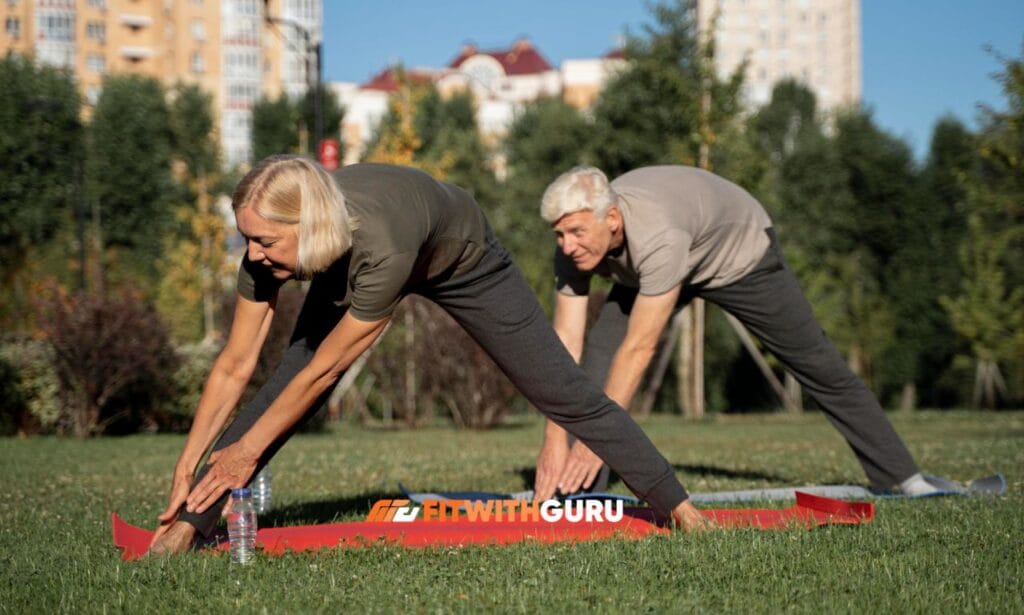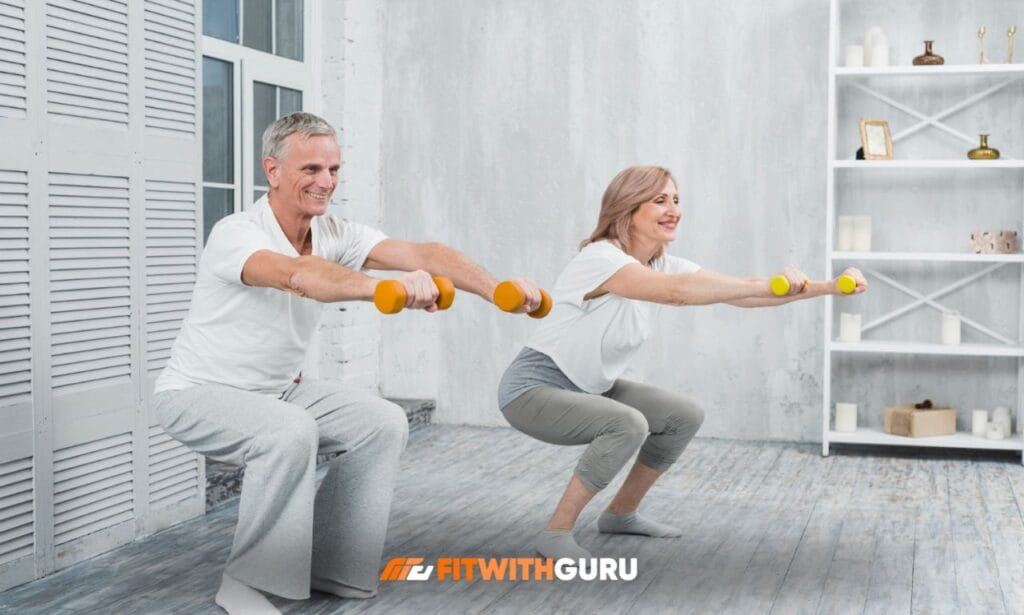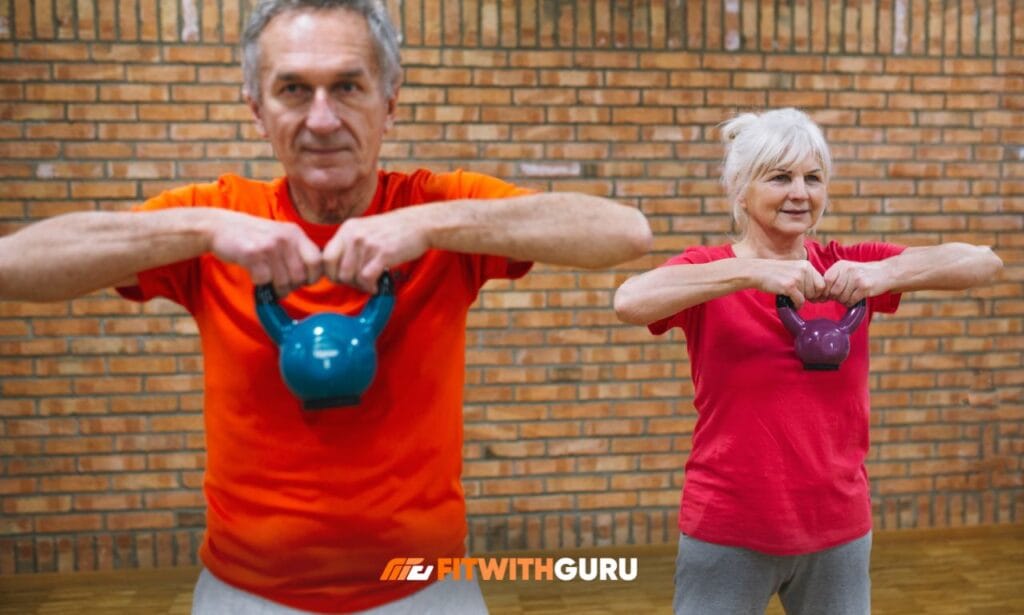Maintaining strength becomes essential to preserving mobility, independence, and overall well-being as we age. Strength training for seniors can significantly improve muscle mass, bone density, and balance, which are crucial for daily activities and fall prevention.
A consistent, well-structured workout routine can also enhance flexibility, reduce chronic pain, and improve mental health, contributing to a higher quality of life.
This 20-minute strength training workout focuses on safe and effective strength training for seniors. It targets key muscle groups while promoting joint stability and flexibility. By incorporating bodyweight movements and simple resistance exercises, seniors can strengthen their muscles and maintain functional fitness without complex equipment or excessive strain.
Why Strength Training is Critical for Seniors
Maintaining muscle strength is vital for preserving overall health and functionality as seniors age. Strength training offers numerous benefits that directly enhance both physical and mental well-being.
It helps seniors maintain independence by improving muscle mass, joint mobility, and balance. Importantly, strength training for seniors also combats some common aging challenges.
One of the most significant age-related concerns is sarcopenia, which refers to the gradual loss of muscle mass and strength. This condition typically begins in one’s 30s but becomes more noticeable in the later decades.
Muscle Mass Decline with Age
Sarcopenia, or the age-related decline in muscle mass, affects nearly everyone as they get older, particularly after the age of 50. The body loses strength and endurance as muscle fibers shrink and become less dense. This muscle loss is a natural part of aging, but can be significantly slowed or even reversed with regular strength training for seniors.
Strength Equals Independence
For seniors, the ability to perform daily activities without assistance is closely tied to their physical strength. Simple tasks like lifting groceries, climbing stairs, and maintaining balance while walking can become more difficult as muscle mass declines.
Strength training enhances these fundamental capabilities, allowing seniors to live independently for longer. Whether carrying shopping bags, getting up from a chair, or maintaining posture while walking, a strong body helps maintain confidence and autonomy in daily life.
Key Principles of Safe Senior Workouts
When it comes to strength training for seniors, safety is paramount. As we age, our bodies become more vulnerable to injury, making it crucial to approach workouts cautiously.
By following key principles, seniors can reap the benefits of strength training while minimizing the risk of harm. These principles are designed to ensure that each workout is effective but also safe and sustainable for the long term.
Low-Impact Movements
One of the most important considerations for seniors engaging in strength training is minimizing joint stress. Low-impact movements are ideal because they reduce the risk of injuries, particularly to the knees, hips, and lower back.
Exercises like bodyweight squats, seated leg raises, and resistance band strength training for seniors effectively build strength without putting unnecessary strain on the joints. The focus should always be on controlled, slow movements that avoid jerking or quick, sudden motions.

Focus on Form and Balance
Focusing on proper form is more important for seniors than performing high repetitions or lifting heavy weights. A well-executed exercise prevents strain on the muscles and joints, which reduces the likelihood of injury. Proper posture and alignment are essential, especially when performing squats, lunges, or basic stretches.
The 20-Minute Strength Training Workout Plan
This 20-minute strength training for seniors is designed to be simple, effective, and safe. It includes a warm-up, a main workout targeting key muscle groups, and a cool-down to improve flexibility and reduce muscle tension.
Warm-Up (3–5 Minutes)
A proper warm-up is essential for preparing your muscles and joints for strength training for seniors, reducing the risk of injury, and improving circulation. This warm-up should be gentle and focus on increasing heart rate and joint mobility.
Marching in Place: Start by marching in place for about 1–2 minutes. Lift your knees high, swinging your arms gently to increase blood flow.
Arm Circles: Extend your arms to the sides and make small circles in both directions for 30 seconds. Gradually increase the size of the circles to engage the shoulder joints.
Leg Swings: Stand near a wall or chair for support. Swing one leg forward and backward for 30 seconds, then switch to the other leg. It will help loosen up your hip joints and improve balance.
Main Workout (12–15 Minutes)
The main workout is focused on functional strength training for seniors that improves strength, balance, and coordination. These exercises target all major muscle groups using minimal equipment, such as a sturdy chair or resistance bands.
- Chair Squats—2 sets of 10–12 reps: Stand with feet shoulder-width apart in front of a sturdy chair. Lower your body as if sitting in the chair, then rise back to standing. This movement works your legs, core, and glutes.
- Wall Push-Ups—2 sets of 10 reps: Stand a few feet away from a wall and place your hands on it at shoulder height. Lower your chest towards the wall by bending your elbows, then push back to the starting position.
- Standing Calf Raises—2 sets of 12–15 reps: Stand with feet shoulder-width apart, holding onto a chair or wall for balance. Slowly raise your heels off the ground, then lower them back down. This exercise strengthens your calves and helps with balance.
- Seated Knee Extensions—2 sets of 10 reps per leg: Sit in a chair with your feet flat on the floor. Slowly extend one leg straight out and hold for a few seconds before lowering it back. Repeat on the other leg.
- Bicep Curls (Band or Dumbbell)—2 sets of 10 reps: Hold a resistance band or light dumbbells with your palms facing up. Slowly curl the weights towards your shoulders, then lower them back down.
- Standing Hip Abduction—2 sets of 10 reps per side: Stand tall, holding onto a chair or wall for support. Lift one leg to the side, keeping your body straight, then lower it back. Repeat on the other leg.
Cool Down (2–3 Minutes)
Finish your workout with a gentle cool-down to reduce muscle tension and improve flexibility in strength training for seniors.
Gentle Stretches: Take 30 seconds to stretch each of the following areas:
- Quads: Stand tall and grab one ankle behind you, pulling it gently towards your glutes.
- Hamstrings: Sit on the floor with one leg extended straight out, and gently reach towards your toes.
- Shoulders: Stretch each arm across your body, holding it with the opposite hand to feel a stretch in the shoulder and upper arm.
By following this 20-minute workout plan, strength training for seniors can gradually improve their strength, mobility, and balance, leading to a healthier, more independent lifestyle.

How to Fit This Workout Into Your Routine
Integrating strength training for seniors into your weekly routine doesn’t have to be complicated. By following simple strategies, seniors can seamlessly incorporate this 20-minute workout into their lifestyle, improving their overall fitness while maintaining a balanced and healthy routine.
Frequency Recommendations
To start, aim for 2–3 strength training sessions per week. It allows ample time for your muscles to recover between workouts while ensuring that you build and maintain strength.
If you’re new to exercise or have health concerns, begin with two weekly sessions and gradually increase the frequency as your body adapts. Consistency is key, so make strength training for seniors a routine.
Combine with Other Activities
Strength training works best with other physical activities, promoting overall fitness. Consider adding walking, yoga, or gardening to your weekly routine.
These activities complement strength training by enhancing flexibility, cardiovascular health, and joint mobility. A balanced approach to physical activity will improve your muscle strength and boost endurance, balance, and flexibility.
Common Mistakes to Avoid
While strength training for seniors can be extremely beneficial, it’s important to avoid common mistakes that can lead to injury or setbacks.
By being mindful of these pitfalls, seniors can ensure they exercise safely and effectively, maximizing the benefits of their workout.
Skipping Warm-Up or Cool Down
One of the most common mistakes is skipping the warm-up or cool-down. Both are essential for preventing injury and reducing muscle soreness. The warm-up prepares your muscles and joints for strength training for seniors, while the cool-down helps to lower the heart rate gradually and stretch the muscles to maintain flexibility.
Neglecting these steps can increase the risk of strains or stiffness. Always set aside time for these important components, even if it means slightly extending the workout time.
Doing Too Much Too Soon
Another mistake is attempting to do too much too soon. While it’s exciting to see progress, pushing your body too hard early on can lead to injury or burnout.
Start with lighter weights and fewer sets, gradually increasing intensity and volume over time. It allows your muscles to adapt safely and build at a steady pace. Emphasizing gradual progression will help avoid unnecessary strain and keep you motivated.

Ignoring Pain or Discomfort
Finally, never ignore pain or discomfort during strength training for seniors. If you experience sharp pain or significant discomfort, stop immediately and reassess your form or the exercise. It’s important to listen to your body and modify exercises if needed.
Pushing through pain can lead to serious injury, so always prioritize safety and adjust the workout to suit your needs. If something feels off, don’t hesitate to stop and make adjustments to ensure a safe and effective workout experience.
FAQs
How often should I do strength training as a senior?
It’s recommended to start with 2–3 strength training sessions per week. It allows your body to recover between workouts while gradually building strength. As you get more comfortable, you can increase the frequency or intensity based on your progress and comfort level.
Can strength training help with balance and mobility?
Yes, strength training for seniors is excellent for improving balance and mobility. Many exercises in this routine target the muscles in your legs, core, and hips, which are crucial for stability and preventing falls. Consistent training can enhance your ability to move more confidently and safely throughout the day.
What if I experience pain while doing these exercises?
If you experience pain while performing any exercise, stop immediately. It’s important to listen to your body and avoid pushing through pain. Modify the strength training for seniors, or try a gentler movement to suit your fitness level. If the discomfort persists, consult a healthcare professional to ensure you perform the exercises safely.
Conclusion
Strength training for seniors is a powerful tool for seniors looking to maintain their independence, enhance mobility, and improve overall quality of life.
By regularly engaging in simple, low-impact exercises, strength training for seniors can build muscle strength, improve bone density, and boost balance, all of which play a vital role in daily activities. The benefits are physical and mental, offering improved mood, better sleep, and increased confidence.
Remember, it’s essential to start slow and focus on consistency. Begin with lighter exercises, gradually increasing intensity as your body adapts. The key to success is not rushing the process but making strength training for seniors a regular part of your routine. With dedication and patience, you can achieve lasting improvements in strength and mobility.

